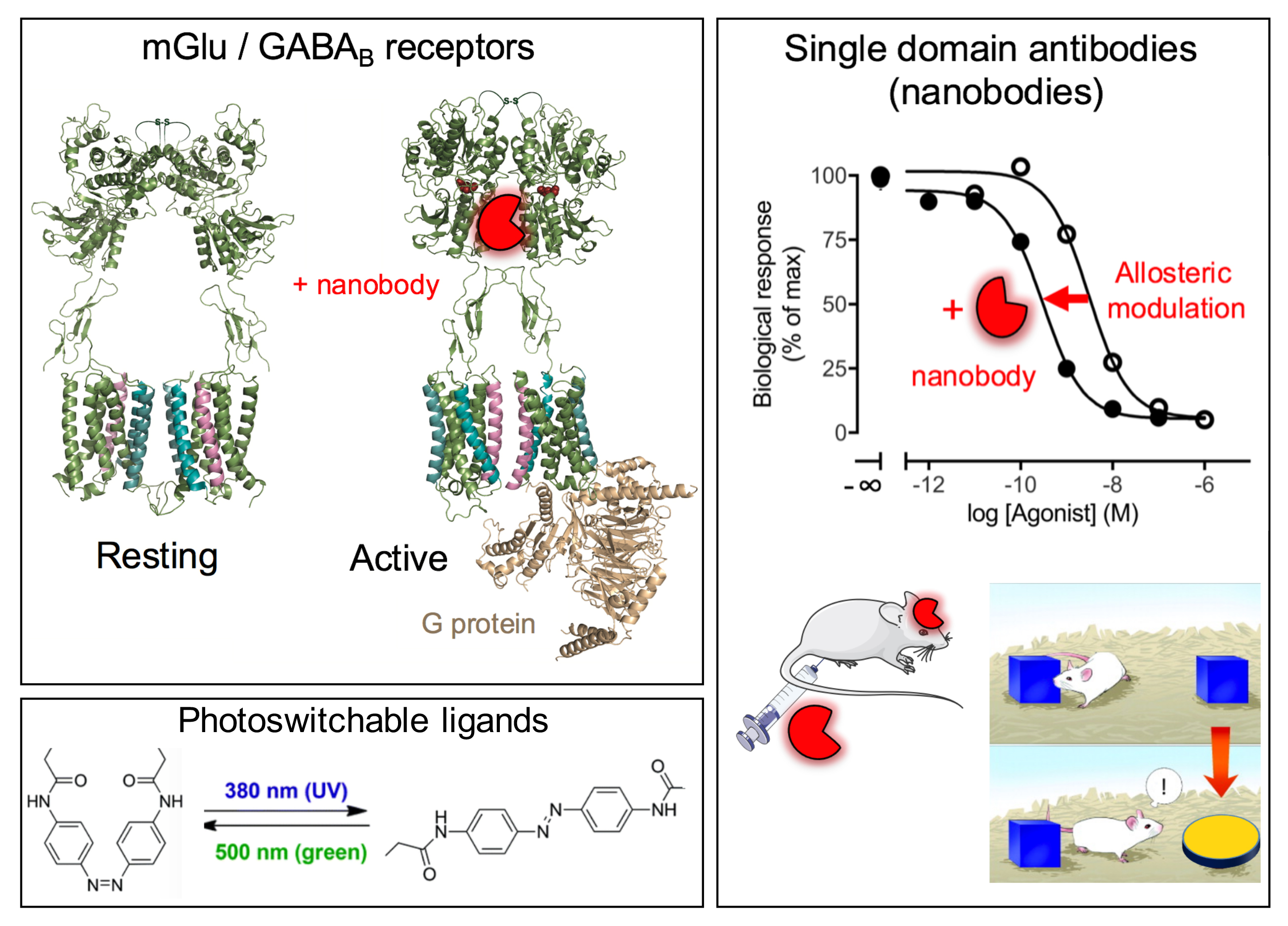NEURORECEPTORS, DYNAMICS AND FUNCTION
Department: Neuroscience
Research subject
The team has a longstanding experience in the field of neuropharmacology, studying G protein-coupled receptors (GPCRs). These receptors represent the main target for drug development, especially in the CNS area for the treatment of both neurologic and psychiatric disorders. Our group made important discoveries in this field by identifying and characterizing the pharmacology and the activation process of the GPCRs for the two main neurotransmitters i.e. glutamate and GABA. Our research projects focus on the 8 different mGlu receptors (mGluRs) and the single GABAB receptor, that are excellent targets for drug development in the neurologic and psychiatric area. We have recently discovered that mGlu subunits could form 16 additional mGlu heterodimers, then offering novel possibilities to modulate brain function more precisely. Finally, all these receptors belong to the class C of GPCRs a family of 22 genes coding for receptors activated by nutrients such as amino acids, calcium and sweet compounds.
Our main goals are :
1 - To elucidate the molecular and cellular mechanisms important for the functioning of homo- and hetero-dimeric mGlu receptors as well as the GABAB receptor, alone or in association with their partners.
2 - To use this information to develop original compounds such as single domain antibodies from camelids (nanobodies) and photo-switchable ligands to control the activity of these receptors.
3 - To develop the nanobodies targeting these receptors for the treatment of various CNS diseases, with a focus on schizophrenia.
Our main goals are :
1 - To elucidate the molecular and cellular mechanisms important for the functioning of homo- and hetero-dimeric mGlu receptors as well as the GABAB receptor, alone or in association with their partners.
2 - To use this information to develop original compounds such as single domain antibodies from camelids (nanobodies) and photo-switchable ligands to control the activity of these receptors.
3 - To develop the nanobodies targeting these receptors for the treatment of various CNS diseases, with a focus on schizophrenia.
 Structural dynamics of the homo- and heterodimeric mGlu and GABAB receptors.
Structural dynamics of the homo- and heterodimeric mGlu and GABAB receptors.
Development of single domain antibodies, or nanobodies, as allosteric modulators of these receptors, and as drugs in vivo in mice models of brain diseases. Development of photoswitchable ligands.
Team
Team leader
Researchers
Technicians and engineers
Postdoctoral researchers and doctoral students
Fixed term contract technicians and engineers
Major publications
- Liu H, Yi P, Zhao W, Wu Y, Acher F, Pin J-P, Liu J, Rondard P (2020). Illuminating the allosteric modulation of the calcium sensing receptor. Proc Natl Acad Sci USA 117 (35) 21711-21722.
- Xue L, Sun Q, Zhao H, Rovira X, Gai S, He Q, Pin J-P, Liu J and Rondard P (2019). Rearrangement of the transmembrane domain interfaces associated with the activation of a GPCR hetero-oligomer. Nat Commun 10, 2765.
- Hajj M, De Vita T, Vol C, Renassia C, Bologna JC, Brabet I, Cazade M, Pastore M, Blahos J, Labesse G, Pin JP and Prézeau L (2019) Non classical ligand-independent regulation of Go protein by an orphan class C G protein-coupled receptor. Mol Pharmacol 96(2):233-246.
- Scholler P, Nevoltris D, De Blundel D, Bossi S, Moreno D., Rovira X, Møller TC, El-Moustaine D, Mathieu M, Blanc E, McLean H, Dupuis E, Mathis G, Trinquet E, Daniel H, Valjent E, Baty D, Chames P, Rondard P* and Pin J-P (2017) Allosteric nanobodies uncover a role of hippocampal mGlu2 receptor homodimers in contextual fear consolidation. Nat Commun 8 (1):1967. * Co-corresponding author.
- Scholler P, Moreno D, Lecat-Guillet N, Doumazane E, Monnier C, Charrier-Savournin F, Fabre L, Chouvet C, Soldevila S, Lamarque L, Donsimoni G, Roux T, Zwier JM, Trinquet E, Rondard P* and Pin J-P (2017) HTS-compatible FRET-based conformational sensors clarify membrane receptor activation. Nat Chem Biol 13, 372-380. * Co-corresponding author.







